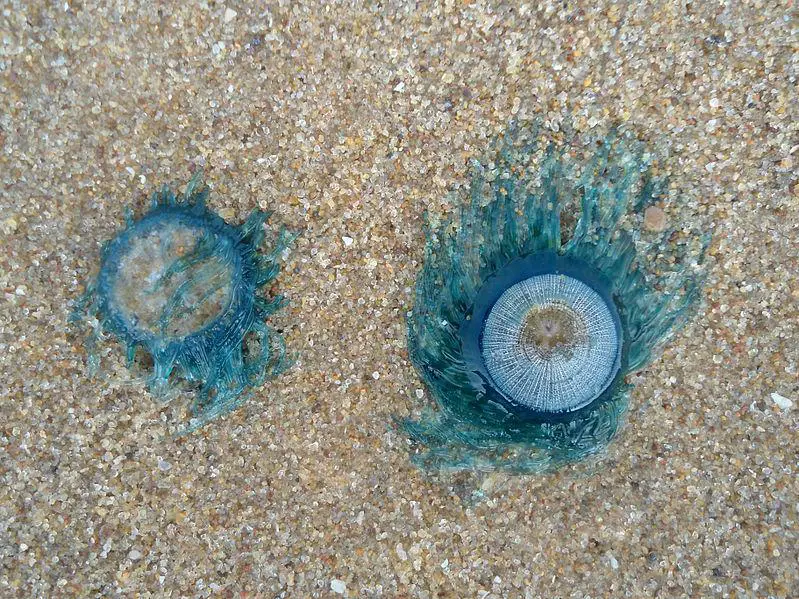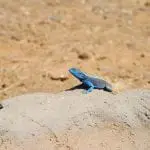The world is a very big place and harbours the most unique creatures. Videos of round, blue sea creatures is very commonly found on social media as people are very intrigued by these odd looking animals. Most people do not even know that these creatures exist which is why when they see them on beaches, their curiosity overtakes them. They take the opportunity to record it on their phones and upload it online. They do this with the hope that someone will give them some input on what these creatures are.
The blue button jellyfish
Commonly known as the blue button jellyfish, the Porpita porpita it is a type of marine organism which belongs to the family Porpididae and class Hydrozoa. It is found in tropical to sub-tropical marine ecosystems where the climate is warmer, especially in places like the Mediterranean Sea.
The Blue button jellyfish, although named a jellyfish are actually not considered jellyfishes as they are not a single organism but a colony of Hydrozoan polyps. It was first reported by Linnaeus in 1758 off the Syrian coast, where he described it as an alien jellyfish.
These creatures float on the surface of water. They are carnivores and predate many small organisms. Their food mainly includes copepods which are small crustaceans that float on water. They also feed on crustacean larvae, plankton and other small organisms that float on the surface of the water. They are highly dependent on ocean currents and winds for transportation. This affects their hunting and preying habits since they cannot move themselves to areas which have food.
These creatures are eaten by larger organisms like sea slugs (Glaucus atlanticus) and violet sea snails.
A fun fact about the Porpita is that they are hermaphrodites which mean they have both male and female sex organs. As mentioned above, a particular polyp is specialised to release both the egg and sperm into the water. The egg and sperm then fertilise to form a new polyp. After going through metamorphosis the fertilised egg develops into a new specialised polyp. The entire Porpita is form when this polyp divides itself to form the different polyps. These then form the colony that makes up the Porpita.
Description
Taxanomy:
Domain- Eukarya
Kingdom- Animalia
Phylum- Cnidaria
Class- Hydrozoa
Order- Anthoathecatae
Family- Porpitidae
Genus- Porpita
Species- Porpita porpita
Since the Porpita is not a single organism, it is made up of two main body parts. The upper disc which floats on the surface of water and the lower part made of tentacles. The upper part is called the float and the lower part is called the hydroid colony.
They are usually 30mm in diameter. Their bodies are gaseous which allows them to float easily on the surface of water. This also makes them very light weight which is why they are easily blown away by wind, tides and sea currents. This is one of the main differences between the porpita and jellyfish. These organisms are only capable of drifting on the ocean surface unlike the jellyfish which can swim deep inside the waters.
The tentacles are actually the different hydroid colony. These tentacles are of various colours, some can be yellow, bright blue or turquoise. Each zoid performs a different function but they all float together on the surface of water. They are specialised for each function like reproduction, preying for food, digestion, etc. The individual strands are made of branchlets which have a knob at the end which acts as a stinger. These knobs are called nematocysts. Although these organisms can sting humans, the sting itself is not dangerous but may cause some irritation.
It is very common for these creatures to wash up onto the sea shore but it is advised not to touch them. Even though their sting is not fatal, it can cause severe skin irritation.
The mouths of these organisms perform both functions of eating and expelling waste. They have an opening at the lower end of the float which serves for both entry of food and expulsion of waste. As weird as this sounds, this is a very common scenario in the animal world. Many organisms have a combined canal for food and waste. Animals like jellyfish, sea anemones, and sea sponges do not have an anus and excrete from their mouths.
Reproduction
A fun fact about the Porpita is that they are hermaphrodites which mean they have both male and female sex organs. As mentioned above, a particular polyp is specialised to release both the egg and sperm into the water. The egg and sperm then fertilise to form a new polyp. After going through metamorphosis the fertilised egg develops into a new specialised polyp. The entire Porpita is form when this polyp divides itself to form the different polyps. These then form the colony that makes up the Porpita.
Habitat
These organisms are found in areas where the temperature is warmer. This includes areas like the Pacific, Atlantic and Indian Ocean. It also includes the areas of the Mediterranean Sea and the eastern part of the Arabian Sea. In Europe, their habitat is mainly restricted to the warmer areas. It is also found in the southern parts of United States, in the Gulf of Mexico, New Zealand,etc.
Feeding habits
Since these creatures drift on the surface of the ocean they are considered passive drifters. They are carnivores and predate many small organisms. Their food mainly includes copepods which are small crustaceans that float on water. They also feed on crustacean larvae, plankton and other small organisms that float on the surface of the water. They are highly dependent on ocean currents and winds for transportation. This affects their hunting and preying habits since they cannot move themselves to areas which have food.
These creatures are eaten by larger organisms like sea slugs (Glaucus atlanticus) and violet sea snails.
What to do when a Blue Button jellyfish stings you?
Even though blue button jelly fish sting is not as dangerous as a jellyfish sting, it can still cause allergic reactions. The main reason they have these stinging cells is to capture prey. Sometimes, while swimming in the ocean, you may just get stung by one of these creatures. When that happens, the first thing you need to remember is to not touch the tentacles with your bare hands. Always cover your hands while you remove the tentacles or any other part which may get stuck to your skin.
The tentacles are very dangerous and when you touch it with your bare hands it may sting your hands as well which will only double your pain. Try to use a towel or gloves to slowly remove the tentacles from your skin. s, To help calm down the skin, use a cold compressed preferably one which contains vinegar or lemon. Do not use urine, warm water, alcohol or freshwater on the area. Try to get to a relief station as quick as possible to avoid any further inflammation.
Effects of climate change on P. porpita
Climate change has affected almost all the ecosystems in the natural world. It has pushed many organisms to the brink of extinction. The worst affected ecosystem being the oceans. The organisms living in the ocean have been so severely affected by climate change that scientists fear there is not going back.
The porpita, although a very small organism as compared to the large creatures present in the ocean, has also been affected by climate change and global warming. The first effect on porpita is the rise in ocean temperatures. Since these organisms thrive in warm temperatures, their global population has increased. They have been appearing in areas where they did not exist before and this has resulted in an ecological imbalance. Recent studies showed that porpitas were being found on the coast of Japan which is alarming considered Japan’s usual low temperature.
Why this is a serious issue? Nature is like a balance beam. In order for proper balance, everything needs to be in proportion. With the rise in organisms like the porpita, there has been competition with other organisms that consume the same food. This imbalance in the food chain may lead to more severe problems in the overall health of the oceanic system.
Another problem related to these organisms is ocean plastic pollution. This has resulted in lack of food for these organisms as most of the small crustaceans get stuck in plastic containers. Also, the larger animals which consume these organisms can mistaken a plastic bag for these creatures since they are both semi transparent. These have all been recent problems faced by not only the porpita but all other ocean life.
Industrial fishing is also a leading cause for concern as these smaller organisms get dragged into the trawler as well. These are also fished to feed the growing demand for other carnivorous fishes which feed on these smaller fishes.
This is why a vegan diet is so important not only to protect land animals but ocean life as well.




